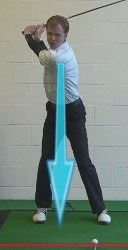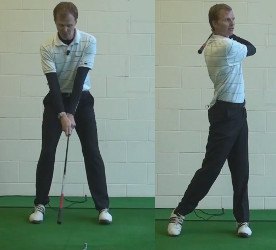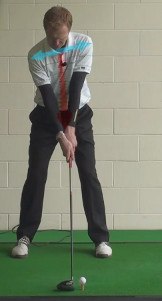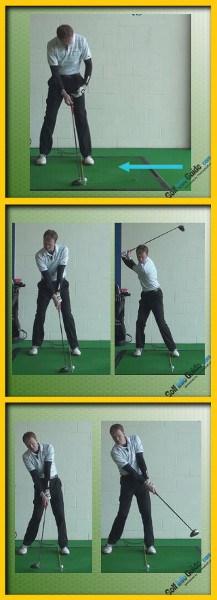
Here’s a phrase you’ll never hear from a golfer: "You know, I think I’m driving the ball too far." Even the longest hitters among us seem constantly in search of extra yards.
It can become an unhealthy obsession if your quest for longer drives causes you to neglect important elements, like accuracy, putting and wedge play. But hitting the ball farther can certainly pay dividends, especially if you struggle to drive it beyond the 200-yard mark.
Several factors can curtail your power. Leading causes include a poor shoulder turn on the backswing, lack of acceleration into the ball and an incorrect angle of attack with the clubhead. Try these tips if you tend to come up short off the tee.
1. Poor shoulder turn: Feet-on-the-ground drill
It’s nearly impossible to hit long drives without a full shoulder turn. While every golfer is different in terms of flexibility, rotating the shoulders until they’re perpendicular (90° angle) to the target line is the long-accepted standard for a good turn.

Test your turn by placing a club across the back of your shoulders and holding it in place. Standing upright, simply rotate to your right (to the left if you’re left-handed) as far as you can comfortably go. Now assume your golf posture and try again. How far did you get?
If you have a hard time reaching the 90° mark, the "feet-on-the-ground drill" will improve your flexibility.
2. Failure to accelerate: Whoosh drill
You’re no doubt aware that the clubhead should reach impact at its fastest speed. You may know that achieving this requires proper body sequencing on the downswing – lower body rotates and pulls the midsection, which pulls the shoulders, arms and club downward with accelerating force.
But did you know there’s an incredibly simple drill to help you build this movement, or that this drill can be done anywhere, without hitting a ball? It’s true – try the classic "whoosh drill" for yourself.

3. Incorrect attack angle: Tilt your spine
If your driver strikes the ball with a descending blow, you reduce the club’s effective loft. This causes the ball to either jump high in the air with excess spin and a short flight, or stay very low to the ground with little carry distance.
Ideally, the driver should be moving ever so slightly upward at impact. A level hit is OK, too, and a tiny amount of downward movement won’t kill you.
The first thing to do is check your ball position. With the driver, it should be opposite your left heel. Once that’s set, it’s crucial that your spine tilts a touch to your right at address – about 5°. In other words, your right shoulder should be slightly lower than your left.
Correct spine tilt not only produces a more powerful clubhead path, it enables you to turn more freely on the backswing and get the club on-plane more naturally.

Change Your Golf Game with Longer Drives
Have you ever met a golfer who was satisfied with their driving distance? Probably not. It seems that no matter how far a golfer is able to hit the ball, they always want to squeeze a few extra yards out of their swing. Most likely, you are the same way. There is nothing wrong with that desire to hit the ball longer, as long as it doesn’t cause trouble in the mechanics of your swing.
Remember, more distance is great, but only if you are able to control it consistently. Long drives that land to the left or right of the fairway aren’t going to do you a lot of good.
When you are trying to figure out how to hit a longer drive, the one thing you don’t want to do is swing so hard that you lose balance. Keeping your balance should always be at the top of your priority list during the golf swing, regardless of how far you are trying to hit the ball. As you learn how to hit long drives, remember to keep balance in mind during any swing changes that you are making. There are plenty of great long drive techniques in golf, and we will go over some of them in the content below – but none of them will be more important than maintaining good balance in your swing.
Before we get into some of the essential tips for long golf drives, let’s go over a few of the advantages that you can gain from learning how to hit longer drives.
- Shorter approach shots. Obviously, being closer to the green after your tee shot on an average par four is going to do great things for your game. If you are hitting approach shots from 150 yards instead of 170 yards, for example, you should be able to hit the green in regulation more often – resulting in more pars and birdies.
- Easier par fives. One of the biggest differences you will see in your game if you are able to learn how to hit long drives is the lower scores you can make on par fives. Even if you aren’t reaching the green in two all the time, you will still be shortening the hole enough to make it far easier than before. When you hit accurate long drives off of the tee on par five holes, you make birdie a very real possibility.
- Added distance with other clubs. When you add swing speed to your driver, there is a good chance that you will add speed to the swing you make with the rest of your clubs as well. That means that not only will you have shorter approach shots thanks to the longer drives, but you will also be able to hit shorter irons thanks to your newfound power.
Using new long drive techniques in golf in your swing is just like any other change you make on the course – it needs to be worked on in the practice area before you take it with you onto the course successfully. While you are learning how to hit a longer drive, be sure to put in enough practice time to where you become comfortable with the changes you have made.
The essential tips for long golf drives that follow are written based on a right handed golfer. For those of you who play left handed, please be sure to reverse the directions as necessary.

The Engine of Long Drives
A variety of factors have to come together in order to hit quality, long drives down the fairway, but there is one that is the engine which really drives the power that you can develop – your shoulder turn. Without a good shoulder turn, everything else that you try to do in order to build power in your swing will be wasted. The rotation of your shoulders in the backswing gets everything started and sets your body into the right position to attack the ball with maximum speed in the downswing. If you aren’t currently getting a good shoulder turn in your backswing, that needs to be the first place you start looking for more distance.
It is one thing to know that you need to make a good shoulder turn in order to create power, but it is another thing to understand exactly what a good shoulder turn feels like. The tricky part is that you can actually rotate too far going back – so you have to strike that perfect balance in order find a good position at the top of the swing. There is no one perfect shoulder turn for every golfer, either. It will depend on factors like your swing plane, flexibility, balance, and more. So, the key to success with your shoulder turn isn’t going to be found in copying someone else. Rather, it will be found in learning how to look for the signs and understand when you have found just the right turn for you.
While working on your shoulder turn, pay attention to the following points –
- Right knee. As you turn back, your right knee should hold its position pretty well. It is okay if your right leg straightens up as you swing back, but the knee shouldn’t be swaying away from the target. When this happens, it is a good sign that you are turning too far for the amount of flexibility that you have to work with. If you notice your right knee swaying away from the target, work on tightening up your backswing until that no longer is a problem. You should turn your shoulders as far as you can while maintaining that right knee position, and no further.
- Flat shoulder plane. Ideally, when you reach the top of your backswing, the plane of your shoulders should be pointing down near the ball. In backswings that stop too short, this won’t happen correctly. Ask a friend to take a video of your swing so you can watch it back later. What does your shoulder plane look like at the top of the swing? If your shoulders are flat and pointing way out in front of the ball, your turn isn’t good enough to generate the speed needed to hit long drives.
- Quick backswing. A good backswing takes a little bit of time. If your backswing seems like it is over in the blink of an eye, you are probably using your arms too much – and not enough shoulder rotation. Allow your backswing to take a little time to develop so you can get your whole body into the right position. Think about moving the club with your shoulder turn while your hands and arms are just along for the ride.
When you watch golf on TV, it is easy to find a variety of different types of swings – all capable of hitting the ball incredible distances off the tee. However, you are going to have a hard time finding even one that does so without a good shoulder turn. Put this fundamental at the top of your list before you work on anything else in your swing with the goal of longer drives in mind. Only when you are confident that you are getting the best possible performance out of your shoulder turn should you consider moving on to other long drive tips.

Unleashing Your Power Potential
With your shoulders properly set at the top of the backswing, you have plenty of power potential loaded up and ready to be released into the ball. Sadly, many golfers waste this power potential and get up hitting weak drives despite a good shoulder turn. What goes wrong? Sequencing. The proper sequencing of your swing is crucial if you are going to take advantage of all of the good work you have done in getting your shoulders turned correctly.
If the shoulders are considered the ‘engine’ of the backswing (and they should be), the lower body can be considered the engine of the downswing. When you arrive at the top of your backswing, the control of your swing should be transferred from your upper body to your lower body immediately. In fact, the very first thing that should move forward toward the target is your lower body. If you are starting the downswing with anything other than your legs, you are wasting potential power and losing club head speed that will cost you yards in the end. It is just that simple.
One word that you can think about to help get the right mental image for your sequencing is ‘uncoil’. You want to uncoil your body from the bottom up, until everything has cleared through the hitting zone. It is a progression, with one part of your body turning through before the next. First your lower body rotates through the hitting area, followed by your torso, your arms, your hands, and finally – the club itself. Think of it as a race, in which the club needs to finish dead last. If the club is beating any of the other parts of your body to the ball during your downswing, you are wasting speed at some point.
The goal of a golf swing that is designed with power in mind is to maximize swing speed at the point of impact. For example, imagine that you have a swing speed of 100 MPH when your club contacts the ball. Nothing wrong with that at all. However, if your mechanics are incorrect, you may find that your club head speed is actually 105 MPH just a few inches behind the ball. That means that you are wasting those extra five miles per hour because your club is slowing down before it ever makes impact. This happens to amateur golfers more often than you would think – and explains why some players who look like they are swinging really hard don’t end up hitting the ball very far in the end.
So, now that you understand just how important sequencing is in your swing, it might be helpful to do a couple drills in order to get a better feeling for how that sequencing should work. First, try the ‘half-speed’ drill. For this, you will just need a club and a safe place to make practice swings. No golf balls necessary at this point. All you are going to do is make your normal golf swing, only at half of its usual speed. Try to keep your mechanics exactly the same as much as possible. Focus on balance and good posture, and notice the order in which various parts of your body are moving. What is the first thing to move when you transition from backswing to downswing? If your lower body isn’t the answer to that question, you will know there is a problem. Swinging slow is a great way to highlight problems in your swing that you didn’t even know existed. After several repetitions of slow swings, go ahead and hit a couple shots (assuming you are at the practice range). Hopefully, you will be able to translate what you have learned in your slow swings and apply it to the real thing.
The second sequencing drill to work on is one that tests your limits in terms of speed and control. On the practice range, try making a few swings (with no ball) with your driver that are as fast as you can make them without falling off balance. These swings may be a little harder than you would ever be comfortable with on the course, but the exercise is meant to teach you how to sequence your body to build that speed. As you work on swinging harder and harder, your brain should naturally figure out the most efficient way to do that. Pay attention to your lower body during the transition again to make sure it is doing its job and engaging like it should. Just like before, hit a few shots down the driving range once you are finished with the practice swings to see how you have progressed.

Other Distance-Adding Tips
With your sequencing now in place, you should be hitting longer drives than ever before. Of course, there is still more you can do to get those last few extra yards out of your swing and make your approach shots as short as possible. Following is a collection of tips that all relate to maximizing your distance off the tee – some of them involve your swing itself, while others are simply strategies that you can use to find more yards.
- Open up your right foot at address. This quick tip can help you gain a little more shoulder turn without losing the position of your right need during the backswing. With your right foot turned open slightly at address, make the rest of your swing like normal. You should feel like there is a little more ‘freedom’ in your backswing, and your shoulder turn should get bigger immediately.
- Do a club fitting. Ask at your local golf shop or golf course about doing a club fitting session. Most shops offer this service, and they should have the computer equipment on hand to do the job. The information you gain from a club fitting can help you to make the most of your swing buy getting equipment that is well-matched to your individual swing characteristics. This step will cost you a small amount of money, but is worth it if you are looking for extra yards.
- Mentally let go of fear. One subtle mistake that can hold people back from reaching their power potential on the course is fear. If you are standing over the ball afraid of where it might go or what hazard it might land it, you are going to be tense and not swinging at your fastest. You need to have confidence and believe in what you are doing at all times. Of course there is always a chance that your shot won’t go where you wanted – but expect good results and play with confidence on the course.
- Tee it higher. Many amateur golfers tee the ball too low because they are afraid of going under it at impact. If your swing technique – specifically your balance – is good, you don’t have to worry about going under the ball because the club will be moving upward through impact. Try teeing the ball up so that the top of your driver is lined up with the middle of the ball at address. This will give you room to swing up through the shot, and should improve your launch angle.
- Play to the safest spot. This goes along with the point about taking the fear out of your swing. When you are picking a target for your driver, pick the line off the tee that gives you the most margin for error. That way, you will be putting your mind at ease knowing that there is a little room to be off-line and still keep your ball safe. If you are too aggressive and aim near to a water hazard or bunker, for example, that dreaded tension is likely to come back into your swing.
Hitting longer drives isn’t always about your swing technique. Sometimes, it is about the decisions you make and the way you are thinking while hitting a shot. By using good thought processes and making a few smart decisions regarding your equipment and the targets that you aim at on the course, more yards can be found without even changing your swing at all.

Fitness Counts
It would be a mistake to have a discussion about driving distance without talking about the importance of fitness to this equation. While you don’t need to be a body builder to hit long drives, it certainly does help to maintain a good base level of fitness. Many people don’t think of golf as being an ‘athletic’ sport, but the golf swing itself is a very athletic motion. In order for your body to be able to generate speed and maintain balance consistently in the swing, you should ideally be as fit as possible.
If you are going to do some golf exercise for longer drives, be sure to work on the following points –
- Flexibility. It is great to improve both, but flexibility is even more important than strength if you were to have to choose between the two. It is your rotation that really builds speed in your swing, so added flexibility should allow you to rotate more and swing faster. Specifically, flexibility in your lower back and upper legs is key.
- Strength in hands and forearms. The connection between your body and the club occurs in your hands, so making them stronger can help to control the club face through impact. This is especially useful when playing shots from long rough where the grass is trying to turn the club head.
- Balance. By now, you should understand how crucial good balance is to your swing. Work on the muscles of your legs and your core to improve your ability to balance throughout your golf swing.
Before undertaking any golf exercise for longer drives, you should consult with a doctor. Also, if you don’t have a lot of experience exercising, consider working with a professional trainer who can help you design a routine that will be both safe and effective for improving your golf swing. Many trainers understand the specific needs of various sports, so if you approach them with the idea of getting better at golf, they may have exercises they can recommend that you do.
Hitting the ball longer off the tee doesn’t need to be a pipe dream, or something reserved for golfers on the PGA Tour. Every golfer can hit the ball farther through an improvement of technique, equipment, fitness, etc. Work through the mechanics of your swing first to see if there is any room for improvement there, and then pursue other methods. As long as you are able to maintain control of the golf ball while you start to hit it longer, those extra yards can quickly translate into saved strokes on the scorecard.






